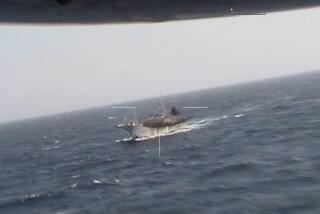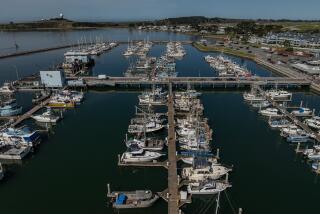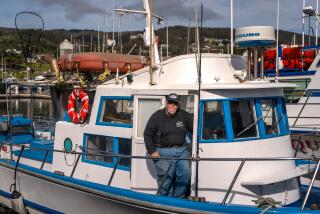Sharing the catch helps save the fish
- Share via
DUTCH HARBOR, ALASKA — After years of dismal reports about collapsing fish stocks and failed fisheries management, scientists will report today that they have discovered how to reverse the trend: Give fishermen exclusive rights to a portion of the catch.
The approach runs contrary to prevailing notions of cutthroat economic competition evident in, for example, “Deadliest Catch,” the TV series about fishermen braving rough seas to catch as much crab as they can in just a few days. But a team of ecologists and economists say that sharing, rather than competing, can make fishing safer, preserve fish populations and even help stocks recover.
“It’s good for the fish, it’s good for the fishermen, but it’s not so good for TV shows,” said Steven D. Gaines, a marine ecologist at UC Santa Barbara.
The Alaskan king crab fishery switched over to “individual fishing quotas” several years ago, following the success stories of Alaskan halibut and pollock and other fisheries in New Zealand and Iceland -- where shares of the catch have been parceled out to existing fishermen, permitting them to fill their quotas in a more rational way.
Today, Gaines joins a pair of resource economists, who analyzed fisheries around the world, in publishing a study in the journal Science that shows how these quotas granted to individual fishermen or fishing cooperatives appear to be working.
The team studied more than 50 years of catch data from 11,135 fisheries worldwide that another team of scientists had compiled to show that nearly a third of the world’s commercial fisheries have collapsed, including the cod fishery off New England and many bottom-dwelling rockfish fisheries off California.
Scientists predicted that if overfishing, pollution and habitat destruction continued unabated, all of the world’s fisheries would collapse by 2048. A fishery is considered collapsed if catches fall to 10% of historic highs.
But the small fraction of those fisheries -- 121 to be exact -- that switched to individual quotas were only half as likely to collapse, according to the study led by Christopher Costello, a resource economist at UC Santa Barbara.
Costello said he was surprised to find that the data showed such clear support for a fundamental tenet of resource economics: A change in incentives can remove the motivation to out-compete someone else and switch to longer-term conservation.
He likens it to handing a milkshake to five kids with five straws. “The incentive is for the kids to slurp like hell even if they get a brain freeze,” Costello said. “Contrast that to dividing the milkshake into five little cups. The kids can enjoy it as long as they want and get a higher payoff.” That’s exactly what we find in fisheries.” Andy Rosenberg, a fisheries expert at the University of New Hampshire, cautioned that as promising as they may be, “it’s not like catch shares solve all of the problems of fisheries management.” He noted that New Zealand’s orange roughy stocks nose-dived despite the switch to catch shares in the early ‘90s.
It remains crucial, he said, for governments to limit the total catch to keep stocks healthy enough to reproduce. And then there’s the problem of fairly distributing the shares, or quotas. Inevitably, Rosenberg said, some fishermen will feel shortchanged and scream that the government “has stolen our heritage.”
The study’s authors acknowledge that catch shares are not a panacea. They note that such quotas don’t have to be doled out to individual fishermen but can be allocated to fishing cooperatives or communities.
The study was funded, in part, by the Paul G. Allen Family Foundation, which donated $5 million to a multi-pronged effort to restore the rockfish and cod fisheries off the coasts of California, Oregon and Washington.
At its November meeting in San Diego, the Pacific Fishery Management Council is set to have a final vote on switching to an individual quota system. It’s designed to follow congressional mandates for more of these quota systems to reduce the number of commercial boats on the water and the amount of “by-catch,” fish caught and shoveled overboard dead because fishermen don’t have permits to land them.
The Alaskan halibut fishery has become the poster child for how the system can work well. It has gone from a deadly race to fish over a few days to a leisurely quota system that has delivered a steady supply of fresh halibut to restaurants and seafood cases and given fishermen more money per pound of fish.
The switch has transformed Dutch Harbor, America’s biggest seafood port, from a seasonal work camp to a year-round town with so many families it needs to build a second school, said Mayor Shirley Marquardt.
“This used to be a town on steroids,” Marquardt said. Businesses would work to exhaustion for a few weeks a year, importing workers for the brief season.
Now catches of crab, halibut and pollock arrive on staggered schedules, resulting in less waste of fish, said Sinclair Wilt, who runs a processing plant here for Alyeska Seafoods Inc. The short-term jobs have evolved into longer-term employment.
Alaska Gov. Sarah Palin, now the Republican vice presidential nominee, briefly worked in Alyeska’s plant in 1987 at the end of her college years. “She was only here three weeks,” Wilt said. “She knows hard work, and she’s eligible for rehire if her current prospects don’t work out.”
--






